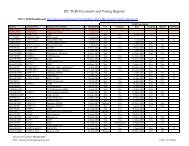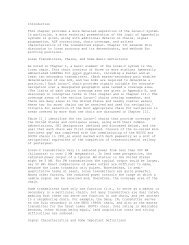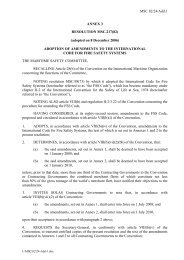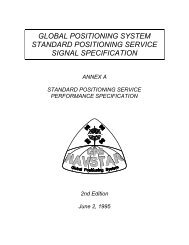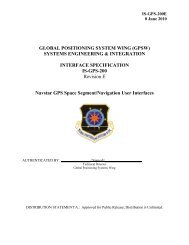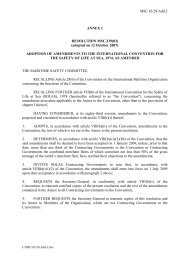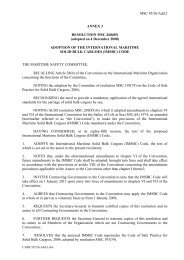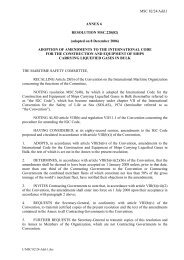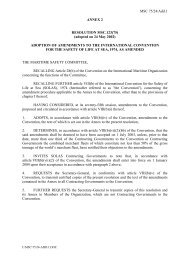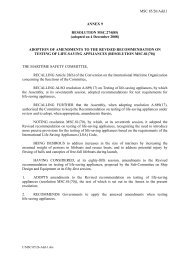IS-GPS-800A - US Coast Guard Navigation Center
IS-GPS-800A - US Coast Guard Navigation Center
IS-GPS-800A - US Coast Guard Navigation Center
You also want an ePaper? Increase the reach of your titles
YUMPU automatically turns print PDFs into web optimized ePapers that Google loves.
3.2.1.8.2 Group Delay DifferentialNot applicable. See Sections 3.2.1.7.1 (Signal Coherence) and 3.5.3.9.1 (Inter-Signal Group Delay DifferentialCorrection).3.2.1.8.3 Space Service Volume (SSV) Group Delay DifferentialL1C SSV group delay differential parameters are provided in TBD.3.2.1.9 Signal Power LevelsThe SV shall provide an L1C signal strength at End-of-Life (EOL), worst-case, in order to meet the minimumeffective received signal levels specified in Table 3.2-1. Any combining operation done by the SV and associatedloss is compensated by an increase in SV transmitted power and thus transparent to the user segment. Forterrestrial users, the minimum effective received signal power is measured at the output of a 3 dBi linearlypolarized user receiving antenna (located near ground) at worst normal orientation, when the SV elevation angle ishigher than 5 degrees and assuming 0.5 dB atmospheric loss. For orbital users, the minimum effective receivedsignal power is measured at the output of a 0 dBi ideal right-hand circularly polarized (i.e. 0 dB axial ratio) userreceiving antenna (in geosynchronous orbit) at 23.5 degrees off nadir and using 0 dB atmospheric loss. Thereceived signal levels are observed within the in-band allocation defined in Para. 3.2.1.1The SV shall provide signals with the following characteristic: the off-axis relative power (referenced to peaktransmitted power) shall not decrease by more than 2 dB from the Edge-of-Earth (EOE) to nadir, nor more than 10dB from EOE to 20 degrees off nadir, and no more than 19.5 dB from EOE to 23.5 degrees off nadir; the power dropoff between EOE and 23.5 degrees off nadir shall be in a monotonically decreasing fashion.Higher received signal levels than those shown in Table 3.2-1 can be caused by such factors as SV temperatureinducedtransmitter power variations, voltage variations and power amplifier variations, and due to variability in linkatmospheric path loss. The terrestrial user’s maximum received signal power level resulting from these factors isnot expected to exceed -154 dBW total for the composite L1C signal. For purposes of establishing user receiverdynamic range for receiver design and test, the maximum received signal power level is not expected to exceed -150dBW total for the composite L1C signal.Table 3.2-1.Received Minimum RF Signal StrengthTerrestrial Orbital Terrestrial OrbitalL1C - 157 dBW - 182.5 dBW*L1C P - 158.25 dBW - 183.75 dBW*L1C D - 163 dBW - 188.5 dBW**Over 99.5% of the solid angle inside a cone with a 23.5 degree half-angle with its apex at the SV and measuredfrom 0 degrees at the center of the Earth.6 <strong>IS</strong>-<strong>GPS</strong>-<strong>800A</strong>8 June 2010




